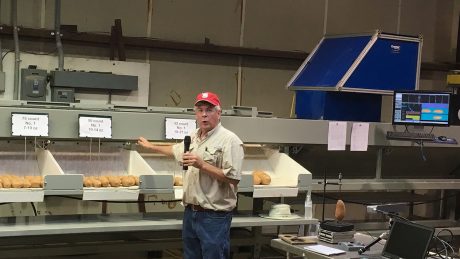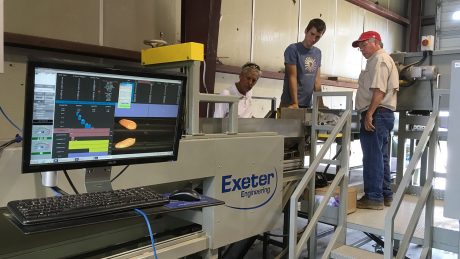A GRIP4PSI Project to Increase the Value of Sweetpotatoes
When it comes to growing sweetpotatoes, North Carolina is a superstar – growing more than the next three states combined.
An interdisciplinary team of researchers at NC State is setting out on an ambitious three-year project that will use artificial intelligence to make sweetpotatoes even more profitable.
The team will work with sweetpotato producers and CALS’ research stations to image hundreds of thousands of sweetpotatoes and then calculate their shape and quality characteristics.
Led by Cranos Williams, a researcher in NC State’s Department of Electrical and Computer Engineering, the team will then combine all of that image data with a host of additional information. When and where were the sweetpotatoes planted? How were they fertilized? What has the weather been like? The researchers can then use advanced machine learning algorithms to determine which factors impact sweetpotato size and shape. Ultimately the goal is to increase the percentage of sweetpotatoes that are USDA grade 1, and thus most profitable for growers.

“Our first step starts with the stakeholders, where we are focused on understanding their values and identifying the things that would improve their profitability,” Williams said. “By understanding what our stakeholders value, we can provide input on how growers, producers and distributors can optimize their processes to potentially reduce the occurrence of misshaped sweetpotatoes. This will translate to decreased waste and increased value.”
Khara Grieger, a senior researcher in the Genetic Engineering and Society Center, is an expert in the intersection of science and society, particularly concerning emerging technologies. She will lead efforts engaging with stakeholders in conjunction with Anders Huseth, a researcher and Extension specialist in the Department of Entomology and Plant Pathology.
The team, including Mike Boyette a Philip Morris Professor of Biological and Agricultural Engineering, has identified quite a number of different factors that might impact sweetpotato shape and size and overall value, but they need to leverage the power of big data and machine learning to be able to sort the metaphorical wheat from the chaff.
The project is one of four interdisciplinary projects selected by NC State’s Office of Research and Innovation to receive seed funding to address the global challenges facing agriculture identified by the North Carolina Plant Sciences Initiative (N.C. PSI).
Measuring Sweetpotatoes
Boyette has spent decades improving the value of the North Carolina sweetpotato industry including work on controlled storage facilities, value-add products and measuring the shape and size of sweetpotatoes.
Boyette has identified quite a number of different factors that might impact sweetpotato shape. These factors include precipitation levels at key stages of growth, the type of fertilizer used and when it is applied, the variety of sweetpotato planted, and soil type.
“We know from anecdotal evidence that all these things and more have an effect on the shape of the sweetpotato,” Boyette said. “You get all of these factors going together but how do you sort these things out? How do you know what you need to do to maximize the value of the sweetpotato? The only way is to measure the sweetpotatoes coming out of the field.”
Boyette, and his summer interns and graduate students, have been working on this for 20 years, starting with calipers, then moving onto a laser scanner. It was tedious and time consuming to measure enough sweetpotatoes for statistical analyses, he said.
Technology has progressed to the point that state-of-the-art packers use an optical scanner to sort their sweetpotatoes. These sorters can scan 100,000 sweetpotatoes in an hour, producing eight to 10 gigabytes of data per minute, Boyette added.
Now, the challenge is collecting all of that data, which is normally discarded, and analyzing it. This is where Williams and other big data, data analytics and data privacy experts come in. This team includes Natalie Nelson, a researcher in Department of Biological and Agricultural Engineering; Edgar Lobaton, a researcher in the Department of Electrical and Computer Engineering; Kemafor Ogan, a researcher in the Department of Computer Science; and Alessandra Scafuro, a researcher in the Department of Computer Science.
“We’re very lucky to be able to put together the team we have put together,” Boyette said. “We’ve got people who are really good at the sensors and scanning. We’ve got people who are really good at big data management and analysis. And ultimately we’ll all work together to improve the value of North Carolina sweetpotatoes.”
Challenge of Big Data
Williams agrees that collecting, managing and analyzing all of the data produced by the current state-of-the-art sorters is a big challenge.
And that doesn’t even take into account the amount of data that will be produced by a new system that will also be capable of measuring internal pest damage and rot that will be developed by team led by Mike Kudenov, another researcher in the Department of Electrical and Computer Engineering, as part of the project.

“One of the biggest challenges we foresee, and something that we’ve been trying to mitigate early, is managing all of the data,” Williams said. “These sorters produce a large amount of data and we have to identify, not only ways of being able to collect it but also effectively store it and manage it. On top of that we will need to collect and manage extrinsic data such as planting and harvesting dates and fertilization information.”
The team is partnering with two companies to assist with this challenge, SAS and Intero Life Sciences. SAS is an analytical software company based in Cary, N.C., with a longstanding partnership with NC State. SAS has many data analysis and data modeling tools as well as considerable experience in data analytics. Intero Life Sciences, a Chapel Hill-based bioinformatics company, is experienced in developing platforms for managing large sets of heterogeneous data, similar to what the project will produce, Williams said.
“We’re looking forward to working with them and gaining their input, in terms of informing the best way to build the type of platform we’ll need for the project,” Williams said. “And in return, our industry partners will have an opportunity to assess how their solutions can be applied to problems that directly relate to agricultural stakeholders. Oftentimes these industry partners have the experience and the tools but they lack the relationships that NC State has been able to develop with stakeholders.”
In addition, the team is partnering with Scott Farms, a sixth-generation family farm in Wilson County that grows more than 3,000 acres of sweetpotatoes, and the NC Sweetpotato Commission.
The partnership with Scott Farms will help the team develop decision-support platforms and establish the proof-of-concept to show the impact of the platform for N.C. sweetpotato growers. The partnership with the NC Sweetpotato Commission provides an effective way of communicating the value of such a platform to increase the production of USDA grade 1 sweetpotatoes to the industry as a whole.
Another aspect of the project is to provide students with hands-on training on tackling agricultural challenges with big data. Daniela Jones, a researcher in the Department of Biological and Agricultural Engineering who heads the agriculture data science certificate program, will lead this aspect. Three undergraduate students will begin working remotely on the project this summer.
“A significant part of our workforce training effort is to expose new students to companies such as SAS as well as enable opportunities on further integrating sensor development and data analytics into agricultural problems,” Williams said. “It was important to us to make sure that we can use this GRIP4PSI project as a mechanism for training the next generation of researchers to be able to tackle problems like this, or even more complex ones.”
The interdisciplinary project is funded by the GRIP4PSI seed-funding program, based on NC State Office of Research and Innovation’s 2016 Game-Changing Research Incentive Program (GRIP). The new program is led by the Office of Research and Innovation in partnership with eight NC State colleges and offices. GRIP4PSI is intended to support visionary ideas in the plant sciences that will result in large-scale funding, meaningful impact for future research and first-class interdisciplinary graduate education and training.
Our interdisciplinary research delivers real-world solutions.
[button] LEARN MORE [/button]
This post was originally published in College of Agriculture and Life Sciences News.



